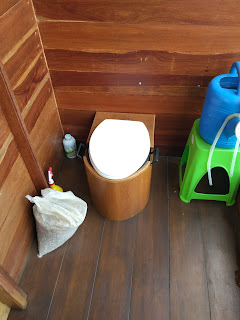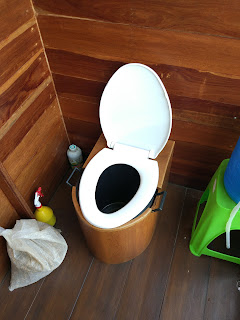A few weeks ago, our team of construction workers finished building us a custom composting toilet for the BaanLoiNaam (the floating house). I am always impressed with their woodworking skills, and really complemented them on this one.
The basic approach we are using here is based on the traditional “Loveable Loo” eco toilet as described in the Humanure Handbook, but we added the curves to fit nicely into the small tiny house bathroom that we have. (Actually, the bathroom isn’t that small, but the house is still tiny.)
We still have some work to do on the overall bathroom before we will start using it (like needing running water to wash the hands after using the toilet), but I’m quite happy with how the loo turned out.
And this design really works well because the floating house is more boat than house, so we will not have any sewage (or water, or electricity) lines going to land.
Here are a few more pictures showing the setup:
Unlike the design we used in BaanRimNaam, this one is more simply built around a standard size bucket that comes with a lid. It slides into the area under the toilet seat and can just as easily slide back out when it is nearing full. Put a lid on the bucket and put it to the side until we have time to dump it in the compost pile, and slide another bucket in to keep the toilet running indefinitely.
Praew and I occasionally watch “Tiny House Hunters” and we always chuckle when the subject of a composting toilet comes up in the show. Nearly every time, one of the partners is curiously interested in the idea, and the other thinks it is fundamentally disgusting. I’ve come to the conclusion that the biggest thing most people that have never used a composting toilet should hopefully consider is that you are throwing large scoops of sawdust in after every use. This means that what is inside the bucket is really very little “bodily fluids” and mostly sawdust. (Besides sawdust, there are other types of compostable organic matter that absorbs smell and brings lots of oxygen pockets with it, but sawdust works the best based on my reading. And after having built 3 wooden houses, we are left with lots of big bags of free sawdust in storage that should last us a few more years if we can keep it from spoiling.)
Having built and used a composting toilet in BaanRimNaam for the better part of a year now, I can honestly say I love it. Every time I end up using a traditional “flush toilet” these days, I not only feel like I am literally flushing perfectly good drinking water down the toilet, but I am also flushing perfectly good composting materials also.
I’m not really a typical “save the world eco warrior”, but I’m willing to give interesting ideas a try, and I have to call it like I see it after considering the options.
And what really surprises me about the composting toilet is that it actually appears to be cleaner than a flush toilet. Both in terms of bacterial growth and in terms of smell. The flush toilet drowns fecal material in water which results in an anaerobic mass of nasty sludge sitting in a septic tank that you really don’t want to go anywhere near, or even be downwind of. And so much of urban sewage management is figuring out how to whisk that toxic stuff away before it contaminates everything it touches.
On the other hand, a composting toilet is all about the much clean aerobic decomposition process. To understand the difference between aerobic and anaerobic decomposition, try to compare the smell of some kitchen scraps scattered lightly around your yard or garden with the same type of kitchen scraps rotting in an airtight container outside for a week or two, the first one breaks down quite cleanly while the second one gets slimy and stinky and is quite disgusting just opening the container to throw the mess into the trash. And while kitchen scraps out in the open in the garden might attract insects, in the composting toilet, sawdust and other cover materials solve that problem too.
And a good composting toilet design is even cleaner. The design we use automatically separates urine out and mixes it with greywater from the shower and sinks and passes it to a drip tube to leach out underground around the trees we planted, providing free fertilizer high in nitrogen and other nutrients year round for no effort at all. This leaves the “number two” (feces) for the main composting drums, where you cover each deposit with a scoop or two of fresh clean sawdust. The sawdust has lots of tiny air pockets, and we used a design for the drums from Biorealis Systems which has a large diameter pipe running down the center of the drum with holes to provide an air passage to keep all parts of the composting materials oxygenated. (As well as a drip pan at the bottom so any excess liquid can be collected away from the composting mixture.) I would estimate that we have about one part human excrement, four parts kitchen scraps (everything from fruit and vegetable cuttings to egg shells), and about 8-10 parts sawdust.
As a result of this mixture and tank design, the entire tank of composting materials stays nice and clean and never really produces anything more than a mild smell of decaying leaves, and we have an exhaust fan down there sucking even that out from under the house and away from people. And by the time we take out the drum and dump it in our new composting hacienda (where we keep humanure composting materials and pure garden cuttings separate in their own reserved chambers), it already looks more like really rich soil than it does like anything that was put in.
After a few months of warm-to-hot composting and a year of “curing” in the composting hacienda, it will be ready to be used in the yard as good compost fertilizer for trees and shrubs and whatever other uses seem appropriate when we get to that point. For now, there isn’t even a noticeable smell in the humanure compost pile immediately after we dump the drum of humanure in and before we cover it with the usual thick layer of straw to keep insects and vermin away.
Anyway, that is enough talk about human excrement for one day. I just hope you come away with the knowledge that a well maintained composting toilet is actually cleaner and less smelly/disgusting than a traditional flush toilet, in addition to being less wasteful. If you managed to read this far into a blog post about pee and poop. 😉



